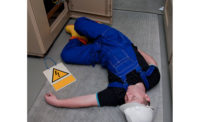Arc blasts can ruin hearing
Sonic blasts can result in immediate & permanent damage

Hearing loss isn’t the first injury that comes to mind when an arc fault occurs. The light and heat emitted by the massive electrical explosion – the arc flash – can cause life-threatening and life-altering burns to the skin, compression injuries and loss of limbs if workers are left unprotected.
The decibel level of an arc flash explosion can reach well over 140 dB. That’s comparable to a jolting gun shot near your head, or a roaring jet engine 100 feet away. The immediate hearing damage from an arc flash blast is painful and irreversible. Hearing loss caused by high level noise exposure cannot be corrected with hearing aids or surgery.
Research findings
Going back to the 1990s, arc flash researchers tested sound levels for arc flash events with incident energies ranging from 5 to 12 cal/cm2. As the arc current increased, they discovered that the peak sound levels also increased. All the sound levels they recorded during testing exceeded OSHA’s noise level exposure limit of 140 decibel impact.
In 2011, the IEEE / NFPA Arc Flash Collaborative Research Project published an update that included the sound level hazards involved during a medium voltage arc flash. The range of incident energy in their test parameters was within 3 to 20 cal/cm2. All the sound levels involved in events tested exceeded 140 dB impact. The duration of the arc had little effect on the sound level, but the magnitude of the short circuit current involved significantly affected the sound level.
At lower levels of decibel impact, the eardrum and internal ear can handle a certain amount of positive air pressure before damage occurs. But at 140 dB impact and greater, there is no safe exposure. Hearing loss and ear damage is immediate.
When the potential peak sound pressure is 140 dB or greater, OSHA states workers should wear personal hearing protective devices to reduce the noise to OSHA recommended limits. OSHA allows eight hours of exposure to 90 dBA but only two hours of exposure to 100 dBA sound levels
In an arc flash situation where the impulse sound resulting from the expansion of the sudden uncontrolled electric current can reach more than 140 decibels, it is important to have appropriate hearing protection that can adapt to sudden impulse sounds, according to the hearing protection devices manufacturer Moldex. The National Fire Protection Association (NFPA) requires workers to wear earplugs, but it does not specify type or noise reduction rating (NRR) requirements in its NFPA 70E-2015.
Specially-made hearing protective devices provide protection for sudden impulsive sounds, such as an arc blast. They can be ear plugs, ear muffs, and communication devices.
What about workers wearing hearing aids?
Says Hugh Hoagland of e-Hazards, “Most hearing aids are not hearing protection. Typically you would remove the hearing aids or use other proper hearing protection. This is not covered directly in NFPA 70E but the risk assessment should be done to evaluate the hazard and risk and then assess proper risk mitigation recommendations.
When it comes to arc flash and blast protection, don’t overlook hearing protection. FR clothing may be the first type of protection that comes to mind, but don’t forget the potential for permanent hearing loss.
Looking for a reprint of this article?
From high-res PDFs to custom plaques, order your copy today!






